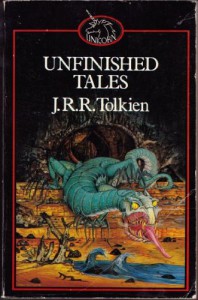A book for die hard Middle Earth fans

I have noticed that the further one drifts from an author's masterpiece the less impressive the writings become, and for Tolkien this is very evident. While I consider his masterpiece to be The Silmarilion (even though it was not actually completed by him) may others look to The Lord of the Rings. Granted, it is a brilliant trilogy, though ever since the films were released their appeal has dropped somewhat in my opinion.
Unfinished Tales is a collection of stories that Tolkien never managed to finish (which is why the book is called 'Unfinished Tales'). They have been revised and published by his son (in the same way that the Silmarilion was) however being incomplete and edited makes them less of a good read than they would have if Tolkien had managed to finish them.
One wonders what Tolkien's purpose was in drafting so many stories, though it appears that he was attempting to create some depth to the world in which the action in the Lord of the Rings takes place. In The Lord of the Rings there are a number of references to the past, and once the books had been completed he appears to have gone to the past to flesh out a lot of these stories.
The stories in Unfinished Tales are divided into four sections, the first three correlate to the various ages of Middle Earth, and the fourth being a description of the Druedain (a race of man), the Istari (a race of 'angels', of which Gandalf is one), and the Planatiri (objects that operate like crystal balls). This book also contains a map and extensive description of the island of Numenor.
Numenor is Tolkien's Atlantis. In fact Tolkien had taken folk tales and legends from across the world's cultures and implanted them into Middle Earth. He hated Shakespeare (considering him to be unimaginative and cliched) and wrote what he considered a better version of the Macbeth prophecy. However Numenor is a tragedy of arrogance (or hubris). The people of Numenor were a strong and prosperous people, however Sauron (a fallen angel) managed to get himself into power on the island and quickly brought about its destruction. The reason behind that was that they believed they could travel to the west to take on the Valar and install themselves as gods in Middle Earth. Obviously taking on the Valar is easier said than done, and in response the island of Numenor was sunk beneath the waves.
It is evident that Tolkien borrowed the story from that of Atlantis, as he had borrowed lots of stories from all over the world to craft Middle Earth. Sometimes I wonder if the world he was creating was supposed to be the Antideluvian civilisation, as he did hold belief in the truth that lay behind many of our myths and legends.


